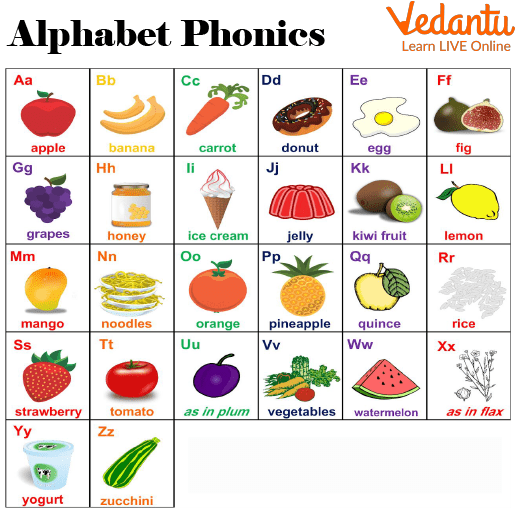




Phonics Sound Chart for Kids - Pronunciation for Beginner
Have you been struggling to teach your child how to read? Sometimes children just aren't able to figure out what some sounds really are by just listening or understanding a word. Then they need something visuals - something that will help them identify the letter combinations and syllables in words quickly so they can be successful in reading soon after starting school.

Pronunciation Beginner Alphabet Phonics Sounds Chart
That’s where Phonic Sound Charts come into action! Phonics Sound Chart explains how phonics works and introduces various alphabet sounds so that children can easily understand how to pronounce English words. This chart can be used to teach the basics of phonic skills to children before moving to more difficult concepts such as reading vowels and consonants.
Beginner Alphabet Phonics Sounds Chart
The alphabet phonics sounds chart contains 26 English letters that represent 46 sounds. Children first learn these phonic sounds. These 46 phonic sounds make the building block of the whole language. This chart contains a letter from A-Z. With the help of this chart, a child is able to learn sounds by seeing the letter. Learning phonics with the help of a printable beginner alphabet phonics sounds chart helps children to make a link between letters and their sounds.
Words Beginner Alphabet Phonics Sounds Chart
Charts that contain words beginning with the alphabet are called words beginning alphabet phonics. These pronunciation beginner alphabet phonics sounds charts contain blends and digraphs. Blends are the combination of words that make a sound like BL, BR, DR, FL, GL, PR, or SM. Digraphs are the letters that make a unique sound like ph makes the sound of “f”.
English Beginner Alphabet Phonics Sounds Chart
A beginner's phonics sounds chart is a great way for children to learn the alphabet and how to read. The English alphabet has 26 letters, which are divided into two categories: consonants and vowels.

Printable Beginner Alphabet phonics Sounds Chart
In order to be able to pronounce these letters, children must first learn how they should sound in order to make sense of them. The phonics sound makes it easier for a child who is learning English because they will already be familiar with the sounds that their letters are made up of.
Rules for Phonics
Every word must have a vowel in every syllable. Some of the vowels that you should know include a, e, I, o, u, and y. (although y is a consonant when at the beginning of a word). The soft sound of "s" is typically heard when "c" is followed by "e, I or y." Consider a city.
Gem's Phonics Rule: The gentle sound of "j" is typically heard when "g" is followed by "e, i or y." Example: gem.
A consonant digraph is a grouping of two or more consonants that represents a single sound. You should be familiar with the following consonant digraphs: wh (what), sh (shout), wr (write), kn (know), th (that), ch (child), ph (graph), tch (watch), gh (laugh), and ng (ring).
Summary
Phonics is a tool to teach the link between sound and letters used for written language. With the help of an English beginner alphabet phonics sounds chart, you can teach your child reading and writing. Phonics makes the base of the child towards language learning. Phonic charts are helpful in teaching new learners about sounds. The phonic sound chart is also helpful for beginners to learn phonetics easily. These charts are made colourful so that early beginners can enjoy learning. These come with pictures that are very helpful and make learning easy and interesting.
FAQs on Phonics Sound Chart
1. What are the methods for teaching phonics?
For a child, learning phonics is a crucial step. Phonics are the building blocks of any language. Teaching English beginner alphabet phonics sounds charts may be a difficult step for some people. There are some effective steps that make teaching phonics easy. Synthetic phonics, embedded phonics, analogy phonics, and analytic phonics are some effective methods used to teach phonics to young learners.
2. Why is it recommended to use phonics in teaching?
Phonics is not just a book review or an alphabet-based course. Rather, it is a set of skills that are designed to teach and practice how to read with the motor skills needed for reading. It is a way to teach basic skills that can be applied across many different curriculums. Best of all, children learn to sound out words very early on in life, so it does not take much time or effort at reading instruction for parents.
3. Is alphabet phonics superior to the whole language?
No. Neither type of program has advantages over the other. Whole language and alphabet phonics are two different approaches that are used with very different goals in mind by different people and teachers. Both whole language and alphabet phonics can be taught well if a teacher has a clear understanding of the principles of each, educational goals for the children, and a reasonable amount of time available for instruction. Poor programs can result in poor reading skills for children if they don't have solid foundations in literacy.
4. Write all the 44 phonic sounds.
44 phonics sounds are s, a, t, p, i, n, m, d, g, o, c, k. Set 4: ck, e, u, r. Set 5: h, b, f, ff, l, ll, ss, y, z, zz, qu,
j, v, w, x, ch, sh, th, ng, ai, ee, igh, oa, oo, ar, or, ur, ow, oi, ear, air, ure, er, ay, ou, ie, ea, oi, ir, ue, wh, ph, ew, aw, au, oe, a to e.















